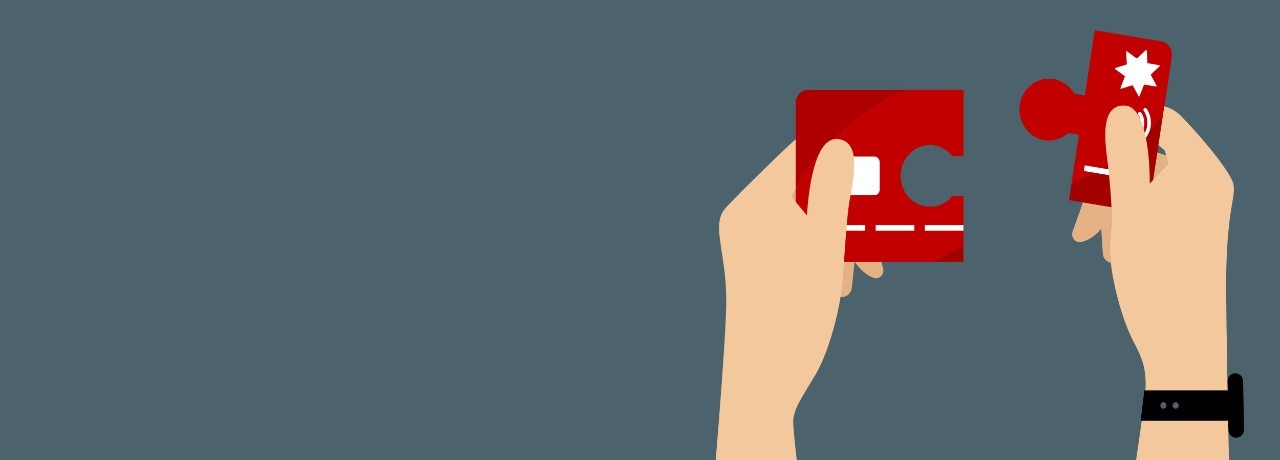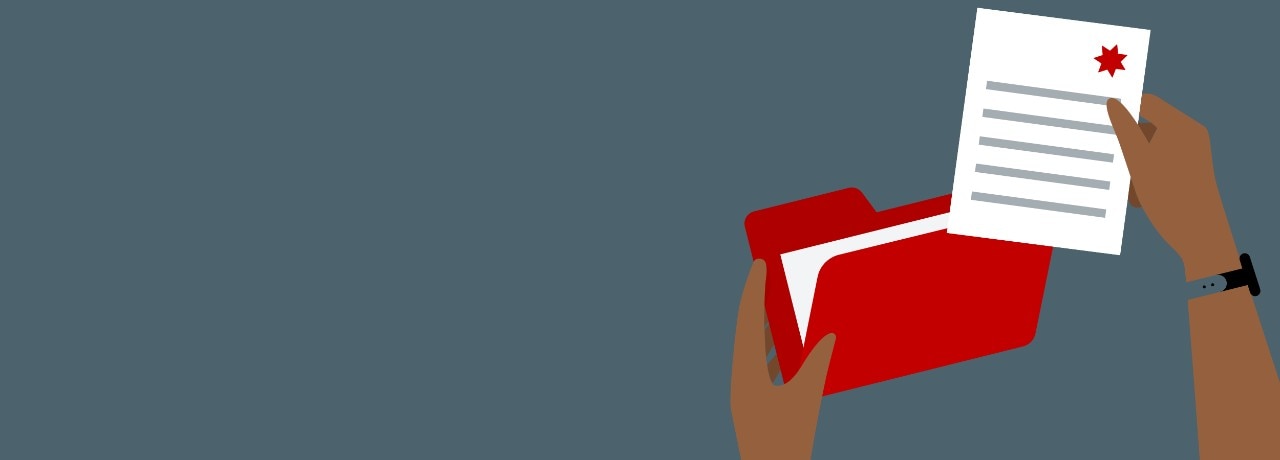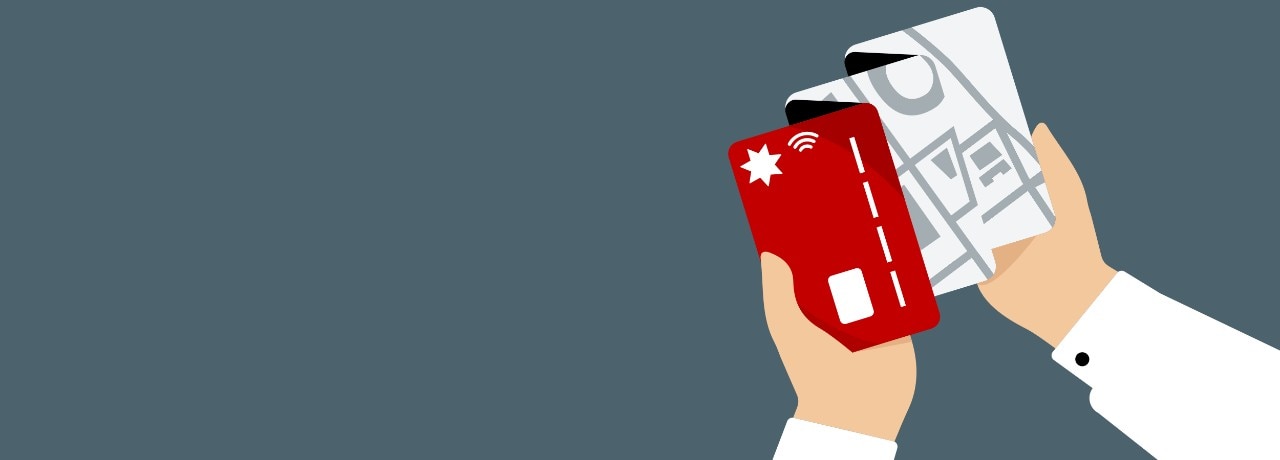NAB StraightUp Card - How things work - NAB
-
1.1 Your account
You must use your account mostly for your private, domestic and household use.
Your account must not be used in ways that break the laws of Australia or another country where you use your card or use your account. At times, we may ask you reasonable questions about your circumstances, including about how you use your account or your transactions.
1.2 Your card
You’re responsible for any card that’s issued to you. This includes keeping the card safe and making sure it is only used by you. You can find out more about what happens if you lose a card, a card is stolen, or if you’re concerned that you didn’t make a transaction, in Sections 6 and 7.
You may transact on your account until the expiry date shown on your card.
Some merchants or financial institutions may not accept your card. We aren’t responsible if they choose not to.
There may be limits for how much you can spend when making purchases using a contactless reader without a PIN (tapping your card). We’ll notify you of these limits when you receive your card.
If you provide your card details to a merchant (for example, where you set up a recurring payment), the merchant may be given updated card details when the card details are changed (such as when we issue a replacement card) if the merchant participates in an account updater service. You should check with the merchant to confirm if they participate. You may request to opt-out of the automatic update of card details by contacting us.
PurchasesMost transactions for goods and services are considered purchases including buying a coffee, paying for a haircut or buying a service online (this could also include using BPAY® services).
Transactions that aren't allowed on your account
Cash advances and gambling transactions are blockedCash advances and gambling transactions from your account are not generally permitted. But if (for whatever reason) we’re unable to identify a cash advance or gambling transaction – and we allow your transaction to occur – it will be treated as a purchase.
For example, this may happen in limited circumstances if certain merchants are not identified as gambling merchants, where our systems are down or the merchant terminal is unable to obtain online authorisations.
Find out more about these blocks.
Balance transfers are not permittedBalance transfers on your account are not permitted. A balance transfer is where you use your account to pay an amount owed on a credit card at another financial institution.
1.4 Fees you'll pay
Monthly credit fees
You may pay monthly credit fees under our agreement. These will be charged to your account – you’ll find more on this in Section 2.
1.5 How transactions work with your account
You agree that we’ll charge your account for the amount of each transaction made when you use your card or your account, as well as the amount of the monthly credit fees payable under our agreement. You must pay the amounts we charge to your account at the times, and in the amounts, described in your agreement with us.
The amount you’re charged for a purchase transaction is what’s shown on a receipt (or similar proof of transaction).
We may assign any date we reasonably consider to be appropriate for any charge to your account or any amount that reduces your outstanding balance (for example, a refund or payment). We may also change the amount or date of any of those charges or reductions – for example, when we need to make a correction. We’ll always do this in compliance with the relevant law and so that a charge to your account is never made earlier than the date the relevant transaction occurred.
1.6 How your credit limit operates
Your credit limit is a cap on how high the outstanding balance on your account can go. How much credit is available to you is whatever your credit limit is – minus the outstanding balance and any transactions which have been made, but not yet added, to your outstanding balance. Here are some important things to understand about your credit limit:
- Your credit limit will determine the amount of the monthly credit fee and minimum monthly repayment amount you will pay. This information is shown in your offer details and is also available on nab.com.au.
- When you apply for your card you can request a preferred credit limit from one of the options specified during the application process. These credit limit amounts are also available on nab.com.au.
- We won’t give you a limit that’s more than what you’ve requested – and you’ll see the agreed amount in your offer details.
- Once your account has been opened, you can request a limit anywhere between the minimum credit limit and maximum credit limit applicable to the NAB StraightUp Card. These minimum and maximum credit limit amounts are available on nab.com.au and are also set out in your offer details (which are current as at the date specified in your offer details).
- There are more details on how to request a decrease to your credit limit in Section 9.
- We may allow you to temporarily exceed your credit limit – if that happens, this excess amount may form part of the total minimum payment shown in your next statement. We'll take reasonable steps to let you know the first time you exceed your credit limit in a statement period, but might not if you repay the excess amount within 2 business days.
1.7 No interest
The NAB StraightUp Card has no interest charges. The annual interest rate is zero percent. This means you’ll never be charged interest on your account because when we apply an annual interest rate of zero percent to your outstanding balance it results in no interest charges.
-
This section describes when and how we calculate and charge the monthly credit fee on your account. You’ll see references to a statement period throughout – which refers to the set period of time we use to record activity on your account (usually 30 days, and usually ending on the same day each month).
The monthly credit fees we’ll apply to your account are shown in your offer details and are determined by the amount of your approved credit limit at the end of a statement period. You can also find this information on nab.com.au.
We’ll reverse your monthly credit fee if you have an outstanding balance of zero during the entire statement period (after allowing for any reversed monthly credit fee) and don’t use your card, or make any purchases, during the statement period.
On the following page we’ll demonstrate scenarios where your monthly credit fee is charged, or charged and reversed, depending on your outstanding balance and if any purchases were made in the statement period. We also explain how you can reduce your monthly credit fee by reducing your credit limit.
Example 1 – Reducing monthly credit fee by reducing credit limit
In the following example, Mary starts out with a credit limit of $3,000. Her monthly credit fee is $30. She has an outstanding balance of $500 and reduces her credit limit to $1,000 during the statement period. Her monthly credit fee for that statement period is reduced to $10.
Example 2 – Zero outstanding balance, purchases made
In the following example, Tom starts out with a balance of zero. He buys a pair of shoes for $100, but pays it back before the end of the statement period. His purchase balance is back to zero at the end of the statement period but, because he made a purchase, the monthly credit fee will be charged. Additionally, as his card has an outstanding balance at the end of the statement period (because of the charging of the monthly credit fee), a repayment will be payable on the payment due date.
Example 3 – Zero outstanding balance, no purchases made
In the following example, Lin starts out with a balance of zero. She makes no purchases over the statement period. Because her balance was zero for the statement period, and no purchases were made on her card, the monthly credit fee will be charged but then reversed. Additionally, because her balance at the end of the statement period is zero, no repayment is payable on the due date.
Example 4 – Outstanding balance, no purchases made
In the following example, Faisal starts out with a balance of $200. He makes no purchases or payments towards that balance over the statement period (although he does make the total minimum repayment by the due date shown on his previous statement). Because his card has an outstanding balance the monthly credit fee will be charged. Additionally, because his card has an outstanding balance at the end of the statement period, a repayment will be payable on the payment due date.
If we change or introduce new fees or charges, we’ll communicate with you as described in Section 13. We may also decide to delay any fees or charges – or not charge you at all. An example of when we may do this is to assist you if you fall into financial difficulty. Information on our standard fees and charges is available on nab.com.au and on request.
-
3.1 Your credit card statement
Your statement shows all of the activity on your account for a period of time (usually 30 days, and usually ends on the same day of each month). This period of time is called your statement period. Your statement also contains information on how much money you owe us and how much you need to pay by the due date. We’ll send you a statement at the end of a statement period, except when it’s not required by law. You can also access these statements electronically on the NAB app and NAB Internet Banking.
3.2 Making sense of your credit card statement
On the first page of your statement you’ll find information about your account, a summary of the charges to your account over the statement period, the amount you owe us and the total minimum payment you must make (which you’ll find more information below). You’ll also find a list of transactions – along with the monthly credit fee applied to your account for the statement period.
Your statement will show the following amounts
Total minimum payment The minimum amount you’re required to pay by the due date. We’ve described how it’s calculated below. You must pay at least this amount by the due date. Closing balance The total amount you owe us at the end of the statement period. 3.3 What to do when you get your statement
1. Check your transaction history
It’s important to check your statement carefully as soon as you receive it. Get in touch with us if you find anything you disagree with or need to dispute a transaction. Make sure you check Section 7 as well, as there are time restrictions for lodging a transaction dispute.
You can contact us using any of the ways shown at the bottom of this page.
2. Pay at least the total minimum payment by the due date
Not making the total minimum payment by the due date could lead to your card or account being suspended. Late or missed payments could also show up on your credit report, along with any default or serious credit infringements. You can see how we calculate your total minimum payment in Section 3.4 below.
3. Consider paying more than the total minimum payment
On your statement, you can see how long it will take you to pay off your closing balance if you’re only repaying the minimum payment. However, if you would like to pay off your NAB Straight Up Card sooner, you should pay more than the total minimum payment.
Keep in mind
You can make additional payments during a statement period – but this won’t be counted as a payment of the total minimum payment that you’ll see in your statement at the end of that statement period.
This means:
- You will still need to pay the total minimum payment by the due date shown in your statement – regardless of how many additional payments you’ve made before that statement period ends.
- You should always consider whether you’ll have sufficient funds to make future total minimum payments before making any additional payments.
However, if you reduce your outstanding balance to $0, you may also be able to avoid ongoing monthly credit fees and the need to make a repayment while the outstanding balance remains at $0. We’ve described how this can happen in Section 2.1.
3.4 How your total minimum payment is calculated
The following amounts are added together to calculate the total minimum payment you see in your statement at the end of each statement period:
Monthly payment
If your closing balance is less than the minimum monthly repayment amount, then your monthly payment is your closing balance.
Otherwise, your monthly payment is the minimum monthly repayment amount. Your minimum monthly repayment amount is a fixed amount determined by the amount of your approved credit limit at the end of a statement period. You can find the minimum monthly repayment amounts in your offer details and on nab.com.au.
You can reduce the minimum monthly repayment amount by reducing your credit limit as explained in section 9.1.
We may change the minimum monthly repayment amount referred to above or the way we calculate the monthly payment and, if we do, we will notify you in accordance with section 13.
Past due or overlimit amount
A past due amount is any amount you had to pay in your previous statement period, but did not.
An overlimit amount is the amount of your closing balance that’s above your credit limit.
If you have one of these, it will be included in your total minimum payment and will need to be paid straight away to fix up your account. If you have both, the higher of the two amounts will be included in the total minimum payment to be paid.
3.5 International transactions
This section deals with international transactions. This will be relevant for you if you:
- use a card overseas; or
- use your account in Australia but the goods or service provider (commonly referred to as a ‘merchant’), financial institution or entity processing the transaction is located outside Australia.
Exchange rates
Where you have an international transaction, the amount we charge to your account will always be in Australian dollars – no matter which currency you pay in. The exchange rate used to calculate the amount of Australian dollars will depend on the currency you decide to pay in.
Exchange rates If you decide to pay in: The exchange rate will be: Australian dollars the rate used by the merchant to convert the foreign currency amount into Australian dollars A foreign currency A rate: - selected by Visa from the range of rates available in wholesale currency markets for the applicable processing date; or
- mandated by a government or government body which is in effect for the applicable processing date
If you receive a refund for an international transaction, the refund amount will be calculated by Visa or the merchant using the exchange rate on the date the refund is processed. This may be different to the exchange rate used when you made the transaction – which means the refund you’re given in Australian dollars could be more or less than the Australian dollar purchase amount.
When international transactions may be declined
Sometimes we may decline international transactions or we may impose limits on international transactions, including in order to comply with the laws of Australia or another country or to protect you or us from loss or to manage risk.
-
Use the NAB app, NAB Internet Banking, NAB Telephone Banking or any other payment option we make available – Find out more about processing times for transfers.
Set up a direct debit from another NAB account or an account from another bank – we process direct debit payments on the due date
BPAY from a bank or financial institution other than NAB – keep in mind it may take up to 2 business days for BPAY1 payments to be received by us
Pay at any NAB branch, or Australia Post outlets (Bank@ Post), during their opening hours4.2 How we apply your payment to your account
Once we receive your payment, we’ll apply your payment to reduce your outstanding balance (or increase any deposit balance you may have). This is done by:
- Taking all amounts which make up your closing balance on your most recent statement and applying your payment to reduce these amounts which remain unpaid.
- If any part of your payment remains available, we’ll apply the remaining part of your payment to reduce the amounts added to your outstanding balance since the most recent statement which remain unpaid.
- If any part of your payment still remains available, this will form part of your deposit balance. If you have a deposit balance, it will be applied to pay any amount charged to your account as soon as that amount is charged. We won’t pay interest on any deposit balance.
We may need to wait until your payment clears before we reduce your outstanding balance (for example, where you make a payment by cheque or direct debit payment).
Dishonoured payments
If a payment doesn’t clear (for example, where you make a payment by cheque or direct debit and the cheque is not honoured or we don’t receive value for the direct debit), we will reverse your payment amount (as a dishonoured payment) and the amount of the reversal will be treated as a purchase.
-
In writing
We may need to send each other communications from time to time. We call these ‘notices’ – and they include offer details, terms and conditions, statements, notices about your account or changes to our agreement, or other documents and communications.
You can give us notice – and we can give the same to you – in the ways described ‘In writing’ below. In addition, we can give you notice by the ‘By publication’ method described below.
In person
We can give each other notices at a NAB branch or registered office.
We consider the notice received on the date on the notice or the date it’s handed over, whichever is later.
By postWe may send you a notice by post to your postal address recorded on our file – so, let us know if your postal address changes. Sometimes, a notice may be a message in your statement.
If you would like to send us a notice by post, our mailing address is: Consumer and Commercial Cards GPO Box 9992 Melbourne VIC 3001
We consider the notice received on the date on the notice or when it would have been delivered in the ordinary course of post, whichever is later.
Electronic communicationsWe can communicate with each other by providing notices by electronic methods (as permitted by law). These methods may include: email, SMS, a message in your statement, or through NAB Internet Banking or the NAB app.
If we communicate with you by email or SMS, we will use the email address or mobile phone number recorded on our file. If you communicate with us by email or SMS, you will need to use an email address or mobile phone number we provided for you to use for that specific purpose.
We consider the notice received on the date on the notice or when it reaches the addressee’s electronic address, whichever is later.
You’ll need to regularly check your electronic communication for any notices we’ve sent you – and let us know if you change your contact details, such as your email address or mobile phone number.
By Publication
We may publish notices electronically and notify you that we have done this.
This includes publishing the notice in NAB Internet Banking, the NAB app, in your statement or on our website, in which case we will usually let you know by SMS or email that the notice is available to view.
We consider the notice received when we let you know that the notice is available for viewing.
We may notify you of changes to fees and charges by publishing a notice electronically, without letting you know by SMS or email (e.g. on our website or through NAB Internet Banking or the NAB app). We’ll follow any regulatory rules in place when we do this. We consider the notice received when it’s available to view.
Continue with another topic
How to manage your NAB StraightUp Card and resolve issues
Find out what to do when your circumstances change or things don’t go to plan.
NAB StraightUp Card definitions and other information
How we define some important words and other important information.
NAB StraightUp Card credit guide
A summary of our lending obligations and what to do if you have a complaint.
View or download a copy of your personal NAB StraightUp Card terms and conditions.
Get in touch
Customer Support Tool
Solve problems quickly online with our easy-to-follow guides. Simply select a topic and we’ll direct you to the information you need.
Contact us
Explore our personal banking contact information and get support with a wide range of products, services and topics.
Visit a NAB branch
Visit us in person at your nearest NAB branch or business banking centre.
Terms and Conditions
Apologies but the Important Information section you are trying to view is not displaying properly at the moment. Please refresh the page or try again later.
BPAY® is registered to BPAY Pty Ltd ABN 69 079 137 518.





